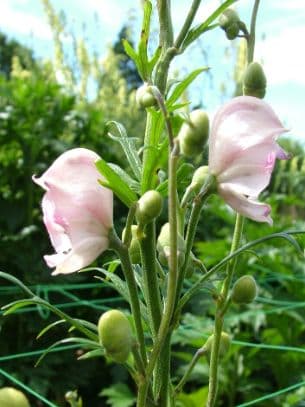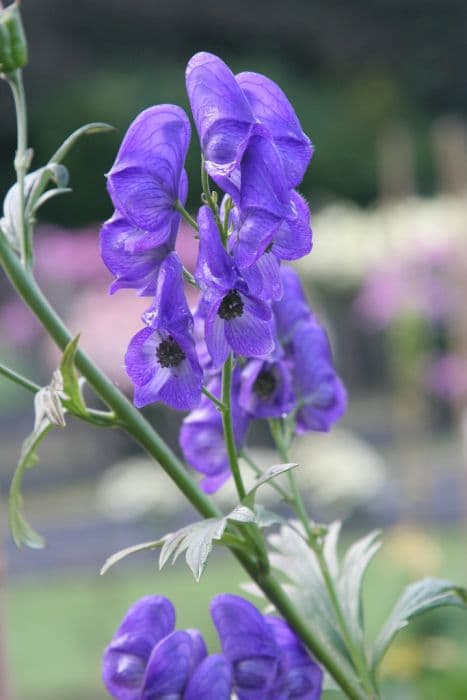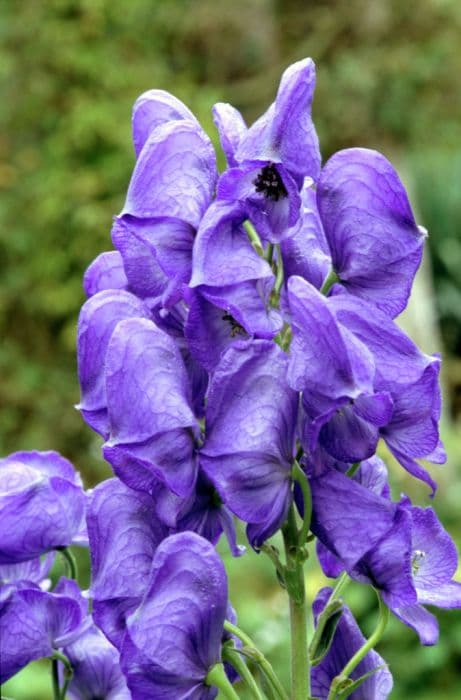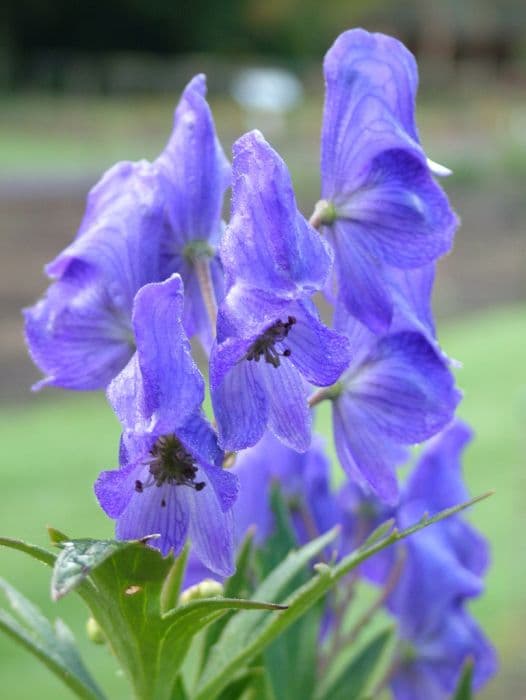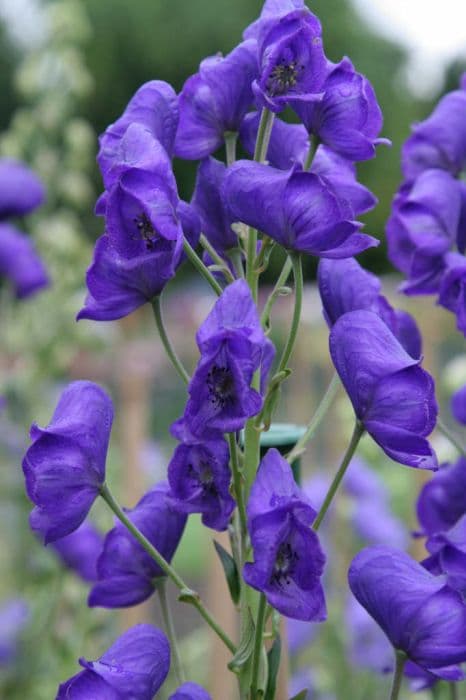Clematis Mayleen Clematis 'Mayleen' (M)

ABOUT
Clematis 'Mayleen' is a vigorous variety of Clematis that is well-loved for its stunning floral display and delightful fragrance. This plant features an abundance of large, satin-like flowers that are tinged with pink and have a heart of cream-yellow stamens which become more pronounced as the flower matures. The petals are gently ruffled at the edges which contributes to their delicate appearance. The leaves of 'Mayleen' are rich green and have a bronzy hue when young, providing a luscious backdrop for the blossoms. The plant boasts a long flowering season, with blooms typically gracing the vine from late spring into early summer, and it may offer a second flowering in late summer or early fall. The attractive seed heads provide additional visual interest after the flowers have faded. Clematis 'Mayleen' is often used for climbing trellises, walls, or pergolas where its ornate flowers can be shown off to beautiful effect.
About this plant
 Names
NamesFamily
Ranunculaceae
Synonyms
Clematis 'Mayleen', Mayleen Clematis, Korean Clematis
Common names
Clematis 'Mayleen'
 Toxicity
ToxicityTo humans
Clematis 'Mayleen', commonly known as Clematis, can be toxic to humans if ingested. All parts of the plant contain compounds called glycosides which can lead to Clematis poisoning. Symptoms may include nausea, vomiting, diarrhea, and salivation. In severe cases, there may be signs of mouth and throat irritation, abdominal pain, and symptoms of gastrointestinal upset. Handling the plant can sometimes cause skin irritation due to its natural irritants.
To pets
Clematis 'Mayleen', commonly known as Clematis, is also toxic to pets, including dogs and cats. The toxicity is due to irritant glycosides present in the plant. If ingested by pets, Clematis can cause symptoms such as drooling, vomiting, and diarrhea. In some cases, ingestion can lead to lethargy, tremors, and seizures depending on the amount consumed. It's crucial to prevent pets from chewing on the plant and to seek veterinary care if they do.
 Characteristics
CharacteristicsLife cycle
Perennials
Foliage type
Deciduous
Color of leaves
Green
Flower color
Pink
Height
20 feet (6 meters)
Spread
10 feet (3 meters)
Plant type
Climber
Hardiness zones
6
Native area
Asia
Benefits
 General Benefits
General Benefits- Attractive Flowering: Clematis Mayleen is well-known for its beautiful pink flowers that can add a splash of color to any garden or landscape.
- Fragrance: The flowers of Clematis Mayleen have a delightful scent that can create a pleasant aromatic environment.
- Versatility: Clematis Mayleen can be trained to climb trellises, walls, and fences, making it versatile for different garden designs.
- Seasonal Interest: With blooms in late spring to early summer, it provides seasonal interest after many spring flowers have faded.
- Wildlife Attraction: The plant attracts pollinators such as bees and butterflies, which are beneficial for the garden ecosystem.
- Easy Pruning: This variety falls within pruning Group 2, which is relatively easy to maintain as it only needs light pruning.
- Rapid Growth: Clematis Mayleen grows quickly, providing fast coverage for garden structures or bare spots.
- Longevity: As a perennial, once established, it can provide beauty for many years with proper care.
- Hardiness: It is hardy in many climate zones, allowing it to be grown in a wide range of environments.
 Medical Properties
Medical PropertiesThis plant is not used for medical purposes.
 Air-purifying Qualities
Air-purifying QualitiesThis plant is not specifically known for air purifying qualities.
 Other Uses
Other Uses- Clematis 'Mayleen' can be used in crafting and floral arrangements, providing an artistic touch to handmade bouquets with its vibrant flowers.
- The vine-like growth habit allows it to be used as a natural privacy screen when grown on trellises or fences in outdoor spaces.
- Due to its climbing nature, it can be trained to grow on various garden structures, such as pergolas or archways, creating living arches and shaded garden nooks.
- The plant offers a habitat for garden fauna; its dense foliage can serve as shelter for beneficial insects and small birds.
- Its attractive seed heads can be used in dried flower arrangements, maintaining visual interest in the garden or home even after the blooming season.
- As a decorative feature, it can be grown in hanging baskets where its trailing vines and flowers can cascade down elegantly.
- The fast-growing vines of Clematis 'Mayleen' can be used in garden competition displays, where rapid coverage and high-impact flowering are advantageous.
- It can serve as a natural curtain to create subtle divisions within garden spaces or on balconies, enhancing the aesthetic of the area.
- Pruned offshoots can be used as propagation material for cultivating new plants, aiding in garden expansion or as gifts for fellow plant enthusiasts.
- When planted near vegetable gardens, Clematis 'Mayleen' can attract pollinators, indirectly benefiting the pollination of nearby edible plants.
Interesting Facts
 Feng Shui
Feng ShuiThe plant Clematis is not used in Feng Shui practice.
 Zodiac Sign Compitability
Zodiac Sign CompitabilityThe plant Clematis is not used in astrology practice.
 Plant Symbolism
Plant Symbolism- Resilience – Clematis 'Mayleen' is known for its ability to climb and adapt to different growing conditions, symbolizing an individual's adaptability and resilience in the face of challenges.
- Ingeniousness – With its climbing habit, the clematis represents ingeniousness and the ability to find creative ways to reach greater heights, both literally and figuratively.
- Mental Beauty – Often, the clematis is associated with the beauty of the mind, perhaps due to the complexity and thought-provoking nature of its winding vines and vibrant blooms.
- Artistic Inspiration – The lush flowers and the clematis' overall aesthetic have been considered an inspiration for artists, symbolizing creativity and artistic expression.
 Water
WaterThe Clematis Mayleen, better known as Traveller's Joy, requires regular watering to maintain moist soil, especially during the growing season. Water the plant deeply once a week with about 1 gallon of water. Adjust the watering schedule during periods of heavy rainfall or drought, ensuring the soil remains moist but not waterlogged. In hot climates or during unusually hot weeks, check the soil moisture more frequently and water as needed to prevent stress.
 Light
LightTraveller's Joy thrives best in a location where it can receive full sun to partial shade. Ideally, the top part of the plant should be in sunlight while the root area remains shaded and cool. The best spot for plant placement would be one where the sunlight reaches the foliage for at least 6 hours a day, which encourages prolific blooming.
 Temperature
TemperatureTraveller's Joy prefers a temperate climate and can survive in a temperature range of 25°F to 85°F, although it thrives in a range of 50°F to 75°F. It is crucial to protect the plant from extreme cold and frost by providing some insulation or choosing a sheltered location.
 Pruning
PruningPruning Traveller's Joy is essential to promote healthy growth and abundant flowering. It's best to prune in late winter or early spring, cutting back the previous year's stems to a pair of healthy buds. This plant flowers on new growth, so annual pruning encourages more stems and blooms. Prune approximately one-third of the old growth to rejuvenate the plant every few years.
 Cleaning
CleaningAs needed
 Soil
SoilFor Clematis 'Mayleen', typically known as the clematis vine, the best soil mix is one that is well-draining, yet retains moisture. It should be rich in organic matter with a pH ranging from 6.5 to 7.5. A mix of garden loam, compost, and well-rotted manure generally works well, ensuring the roots stay cool and shaded.
 Repotting
RepottingClematis 'Mayleen' should be repotted every 2 to 3 years or when it outgrows its current container. They prefer to be planted with their roots in shade and stems in sun, so consider this when choosing a location after repotting.
 Humidity & Misting
Humidity & MistingClematis 'Mayleen' is adaptable to a range of humidity levels and thrives outdoors where it can receive natural humidity. It doesn’t require any special humidity adjustments when planted in the garden.
 Suitable locations
Suitable locationsIndoor
Provide strong light, cool roots, and trellis for support; prune as needed.
Outdoor
Plant in fertile soil, partial shade for roots, support for climbing; prune as needed.
Hardiness zone
4-9 USDA
 Life cycle
Life cycleClematis 'Mayleen' begins its life as a seed, which upon germinating develops into a young seedling with its first set of true leaves. As it matures, it becomes a vigorous climbing vine, known for its rapid growth and ability to cover trellises, walls, or other supports. During spring and early summer, 'Mayleen' produces an abundance of fragrant pink flowers, attracting pollinators and marking its reproductive phase. After flowering, the plant produces feathery seed heads that disperse seeds, facilitating the potential for new plants to grow in suitable conditions. Each year, 'Mayleen' enters a period of dormancy in the winter, where above-ground growth slows down or dies back, while the root system remains alive to resume growth the following spring. This perennial cycle of growth, flowering, seed production, and dormancy continues throughout the plant's lifespan, which can span several years with proper care.
 Propogation
PropogationPropogation time
Spring-Early Summer
The most popular method of propagation for Clematis 'Mayleen' is by semi-hardwood cuttings. This technique is typically carried out during the summer, from mid-June to August, when the plant’s new growth has partially matured but is not yet fully hardwood. To propagate, a gardener should select a healthy stem, cut a segment of about 4 to 6 inches (10 to 15 centimeters) long with at least two sets of leaves, and make the cut just below a leaf node. The lower leaves are then removed, and the cut end can be dipped in rooting hormone powder to increase the chances of successful root development. The prepared cutting is then planted in a pot filled with a well-draining potting mix, with about half the length of the cutting buried in the soil. It is important to maintain consistent moisture and keep the cutting in a warm place with indirect sunlight until roots develop, which usually takes a few weeks to a couple of months.
